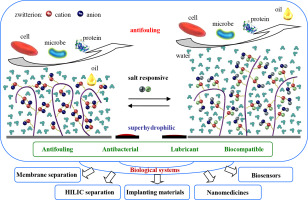Advances in Colloid and Interface Science ( IF 15.9 ) Pub Date : 2020-03-16 , DOI: 10.1016/j.cis.2020.102141 Dongxiang Li , Qianling Wei , Chunxing Wu , Xiaofang Zhang , Qihao Xue , Taoran Zheng , Meiwen Cao

|
In recent years, zwitterionic polymers have been frequently reported to modify various surfaces to enhance hydrophilicity, antifouling and antibacterial properties, which show significant potentials particularly in biological systems. This review focuses on the fabrication, properties and various applications of zwitterionic polymer grafted surfaces. The “graft-from” and “graft-to” strategies, surface grafting copolymerization and post zwitterionization methods were adopted to graft lots type of the zwitterionic polymers on different inorganic/organic surfaces. The inherent hydrophilicity and salt affinity of the zwitterionic polymers endow the modified surfaces with antifouling, antibacterial and lubricating properties, thus the obtained zwitterionic surfaces show potential applications in biosystems. The zwitterionic polymer grafted membranes or stationary phases can effectively separate plasma, water/oil, ions, biomolecules and polar substrates. The nanomedicines with zwitterionic polymer shells have “stealth” effect in the delivery of encapsulated drugs, siRNA or therapeutic proteins. Moreover, the zwitterionic surfaces can be utilized as wound dressing, self-healing or oil extraction materials. The zwitterionic surfaces are expected as excellent support materials for biosensors, they are facing the severe challenges in the surface protection of marine facilities, and the dense ion pair layers may take unexpected role in shielding the grafted surfaces from strong electromagnetic field.
中文翻译:

超亲水性和强盐亲和力:两性离子聚合物接枝的表面具有巨大的潜力,尤其是在生物系统中
近年来,两性离子聚合物经常被报道修饰各种表面,以增强亲水性,防污和抗菌性能,尤其在生物系统中显示出巨大的潜力。这篇综述集中在两性离子聚合物接枝表面的制造,性能和各种应用上。采用“接枝”和“接枝”策略,表面接枝共聚和后两性离子化方法在不同的无机/有机表面上接枝两性离子聚合物。两性离子聚合物固有的亲水性和盐亲和力使改性表面具有防污,抗菌和润滑性能,因此,所获得的两性离子表面在生物系统中显示出潜在的应用前景。两性离子聚合物接枝的膜或固定相可有效分离血浆,水/油,离子,生物分子和极性底物。具有两性离子聚合物壳的纳米药物在封装药物,siRNA或治疗性蛋白质的递送中具有“隐身”作用。而且,两性离子表面可用作伤口敷料,自修复或吸油材料。两性离子表面有望作为生物传感器的极佳支撑材料,它们在海洋设施的表面保护中面临严峻挑战,致密的离子对层可能在保护接枝表面免受强电磁场的作用方面出乎意料。具有两性离子聚合物壳的纳米药物在封装药物,siRNA或治疗性蛋白质的递送中具有“隐身”作用。而且,两性离子表面可用作伤口敷料,自修复或吸油材料。两性离子表面有望用作生物传感器的极佳支撑材料,它们在海洋设施的表面保护中面临严峻挑战,致密的离子对层可能在保护接枝表面免受强电磁场的作用方面发挥了出乎意料的作用。具有两性离子聚合物壳的纳米药物在封装药物,siRNA或治疗性蛋白质的递送中具有“隐身”作用。此外,两性离子表面可用作伤口敷料,自修复或吸油材料。两性离子表面有望作为生物传感器的极佳支撑材料,它们在海洋设施的表面保护中面临严峻挑战,致密的离子对层可能在保护接枝表面免受强电磁场的作用方面出乎意料。











































 京公网安备 11010802027423号
京公网安备 11010802027423号